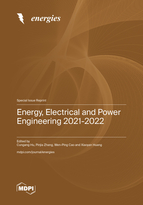Energy, Electrical and Power Engineering 2021-2022
A special issue of Energies (ISSN 1996-1073). This special issue belongs to the section "F: Electrical Engineering".
Deadline for manuscript submissions: closed (31 May 2023) | Viewed by 34784
Special Issue Editors
Interests: electric machines and drives; power electronics; power system analysis; new and renewable energy; big data analytics
Special Issues, Collections and Topics in MDPI journals
Interests: renewable energy; micro grid and energy storage; monitoring
Special Issues, Collections and Topics in MDPI journals
Interests: electrical machines and drives; power electronics; power systems; wind power; electric vehicles
Special Issues, Collections and Topics in MDPI journals
Interests: permanent magnet motor; high speed train traction system; high efficiency motor drive system for EV; fault tolerant motor drives for aerospace; PMSM motor intelligent control
Special Issues, Collections and Topics in MDPI journals
Special Issue Information
Dear Colleagues,
Energy and power are playing an increasingly pivotal role in our modern life and are transforming the way we utilize energy and the way we live. This special issue will bring together the latest innovations and knowledge in energy and power engineering such as new and renewable energy, power electronics and electric motor drives, distributed generation and multi-energy systems, data analytics, and artificial intelligence. You are cordially invited to contribute to the Special Issue and present your new work.
Submissions are invited from authors of accepted post-conference papers presented at the CoEEPE’21 and CoEEPE'22 conferences. The Scientific Committee of the conference will select conference papers for this Special Issue. In addition, we also collect original research and review papers which are not from the conference on the following topics.
Topics of Interest include but are not limited to:
- Analogue and Digital Signal Processing
- Artificial Intelligence
- Big Data and Data Processing
- Bioenergy and Utilization
- Communication Systems
- Control Theory and Optimisation
- Diagnosis and Sensing Systems
- Distributed Generation
- Electrical Generators
- Electrical Motor Drives
- Electromagnetic and Applied Superconductivity
- Electronics, Information and Control Systems
- Energy Market and Power System Economics
- Energy Storage
- Engineering Materials and Process
- Fuel Cells and Applications
- Industrial Process Control and Automation
- Intelligent control systems
- Mechatronics and Robotics
- Modeling, Simulation, and Analysis
- Nuclear Energy
- Power Electronic Converters
- Power Generation and Sustainable Environment
- Power Quality and Electromagnetic Compatibility
- Power Planning and Scheduling
- Power Semiconductors
- Predictive Control
- Protection, Operation, and Control
- Real-Time Control
- Reliability and Security
- Renewable Energy
- Sensors, Instruments, and Measuring Technologies
- Smart Cities and Smart Grids
- Solar energy and photovoltaics
- Transmission and Distribution Systems
- Wind energy
Thank you very much for your participation!
Prof. Dr. Cungang Hu
Dr. Pinjia Zhang
Prof. Dr. Wen-Ping Cao
Prof. Dr. Xiaoyan Huang
Guest Editors
Manuscript Submission Information
Manuscripts should be submitted online at www.mdpi.com by registering and logging in to this website. Once you are registered, click here to go to the submission form. Manuscripts can be submitted until the deadline. All submissions that pass pre-check are peer-reviewed. Accepted papers will be published continuously in the journal (as soon as accepted) and will be listed together on the special issue website. Research articles, review articles as well as short communications are invited. For planned papers, a title and short abstract (about 100 words) can be sent to the Editorial Office for announcement on this website.
Submitted manuscripts should not have been published previously, nor be under consideration for publication elsewhere (except conference proceedings papers). All manuscripts are thoroughly refereed through a single-blind peer-review process. A guide for authors and other relevant information for submission of manuscripts is available on the Instructions for Authors page. Energies is an international peer-reviewed open access semimonthly journal published by MDPI.
Please visit the Instructions for Authors page before submitting a manuscript. The Article Processing Charge (APC) for publication in this open access journal is 2600 CHF (Swiss Francs). Submitted papers should be well formatted and use good English. Authors may use MDPI's English editing service prior to publication or during author revisions.
Keywords
- power converters
- motor drives
- electrified vehicles
- wind power generation
- measurement techniques
Related Special Issue
- Energy, Electrical and Power Engineering 2024 in Energies (8 articles)









